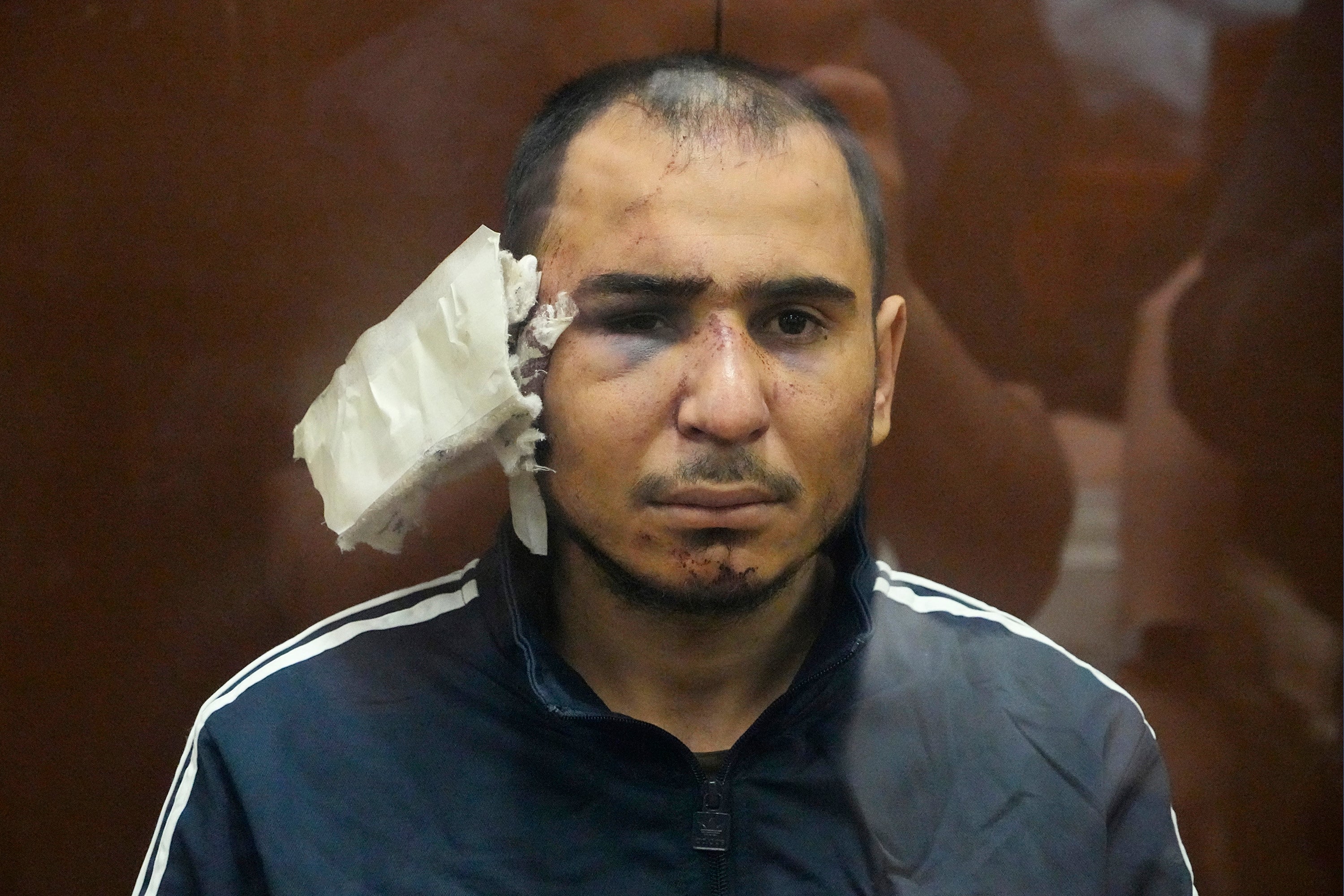The Independent's journalism is supported by our readers. When you purchase through links on our site, we may earn commission.
The proof that Putin’s Russia is nothing more than a criminal state
Torture by the state is prohibited under the Russian criminal code – not that it seems to make much difference, warns Kim Sengupta. What we are seeing in the treatment of the Moscow attack suspects is nothing short of revelling in violence


The images from Moscow’s Crocus City Hall conveyed the full horror of the savage massacre: 137 people slaughtered, another hundred left injured in pools of blood in the attack carried out by Islamist terrorists.
Then, other graphic footage began to appear. One of the suspected gunmen, 30-year-old Saidakrami Rachabalizoda, lying on the ground as a security officer seemingly cut off his ear and stuffed it into his gagging mouth. He appeared in Moscow’s Basmanny District Court the next day with a large bandage covering the missing ear.
Another photo circulated online showed a second suspect, 25-year-old Shamsidin Fariduni, with his trousers and underwear around his knees, wires from a battery attached to his genitals, while a man stands on his leg. Comments could be heard, off-camera, on the best way to extract information with this method while inflicting pain.
A third alleged accomplice, Dalerjon Mirzoyev, 32, appeared in court with extensive bruises and cuts to his face and a plastic bag around his neck. The fourth suspect, Muhammadsobir Fayzov, 19, was brought into the hearing unconscious, on a stretcher – a catheter on his lap, accompanied by a doctor.
The use of torture by the state is prohibited under the Russian criminal code. Article 117, introduced in 2003, states: “For the purposes of this article and other articles of the code, torture shall be defined as infliction of physical and moral suffering aimed coercing an individual into giving evidence or committing acts against his will, as a punishment – and, or, for other purposes.”
In 2022, a separate component of Article 286 of the criminal code – Part 4 – was introduced focusing on the issue of torture and explicitly prohibiting its practice mentally or physically.
This may raise a hollow laugh in the context of what we have seen being done to those arrested over the Moscow attacks. But although mistreatment and physical abuse often take place in Russia at local and regional levels, it is highly unusual to see it carried out in such a wanton fashion – and so publicly.
Other less publicised and less violent footage has appeared on social media in the aftermath of the Crocus killings. A car full of young Muslim men pulled out of their vehicle, beaten and arrested by police for showing disrespect to the dead by playing music too loudly. The Tajik background of the gunmen was allegedly used to justify assaults on members of the Tajik diaspora and others from central Asia by police at a number of places.
The torture of the Crocus Hall suspects has been lauded by public figures in the establishment. Margarita Simonyan, the head of the state broadcaster RT, said: “I never expected this from myself, but when I see how they are brought into court crooked, and even this ear, I feel extremely satisfied.”
Former president Dmitry Medvedev, deputy chair of the Security Council, appeared to want to reverse Russia’s de facto abolition of capital punishment by bringing in summary executions. Although the death penalty remains on the statute, no executions have been carried out since 1996 – when president Boris Yeltsin issued a decree to bring in a moratorium.
“Do they have to be killed? They have to be and will be,” said Medvedev. “Who paid, who helped, who sympathised, kill them all.”
Human rights activists have protested at what is unfolding. Olga Sadovskaya, a prominent lawyer and member of the Committee Against Torture, has collected evidence of torture in Russian jails, penal colonies, police stations and psychiatric institutions over many years.
She said: “Everything that was seen in the videos and photographs of the suspects completely fits the description of torture. As a matter of fact, this is a crime that we witnessed on live television. The situation is sending two messages. First, to those who may be planning something like this: ‘Look how we’re going to treat you, this is how we treat everyone who commits this kind of crime.’ Second is to the public: ‘The victims have been avenged, retribution was immediate.”
Sadovskaya and her team have won a number of international awards, including the Andrei Sakharov Freedom Award – and have been shortlisted for the Nobel Peace Prize. They had, during their work, come across extensive cases of state repression.
But Sadovskaya was still surprised by the sense of impunity shown in the torture of the Moscow suspects. “The level of tolerance for torture is still very high in Russian society, but I don’t recall a situation like this at the national level. Today’s situation is a normalisation of violence. This blatant demonstration of torture signals that it is now permitted and there is no end to it.”
State violence is not, of course, new to Russia. The death of Alexei Navalny last month at his prison colony in the Arctic Circle was a lethal illustration of what happens to those who publicly oppose the Kremlin and Vladimir Putin. Boris Nemtsov, assassinated in Moscow in 2015, is another who paid the ultimate price for daring to speak out.
Being abroad while criticising the regime does not put one beyond brutal retribution, as the killing of Alexander Litvinenko in London and the attempted poisoning of the Skripals showed.
The scale of extra-judicial killings rises manifold in times of conflict. The seeds of the murders in the Moscow concert hall were sown long ago, in the bloody strife enacted in Chechnya and on the steppes of central Asia.
The war in Ukraine has contributed to the acceptance of violence. We have seen evidence of extensive torture and killings of civilians, often systematic, in occupied regions, carried out (at times) by convicts conscripted into the Russian forces in return for being pardoned for their crimes.
And the celebration of cruelty and viciousness is seeping into communities back in Russia, civil rights organisations have warned. Ivan Pavlov, a defence lawyer who has taken part in a number of security-related cases, pointed out that torture was often a standard form of interrogation in cases of terrorism and murder.
“The difference is that in the past the authorities hid this from the public,” he said. “They are not doing this now because the public is more ready to accept violence. This is no longer shocking and unpleasant for people because of this war.”
Aleksandr Solzhenitsyn said of state brutality: “Violence can only be concealed by a lie – and the lie can only be maintained by violence”.
What we are seeing now is a Russian state not bothering to conceal violence, and actually glorying in unleashing it. The Kremlin may find that a society it is actively brutalising will be difficult to control in the future.
Join our commenting forum
Join thought-provoking conversations, follow other Independent readers and see their replies
Comments
Bookmark popover
Removed from bookmarks